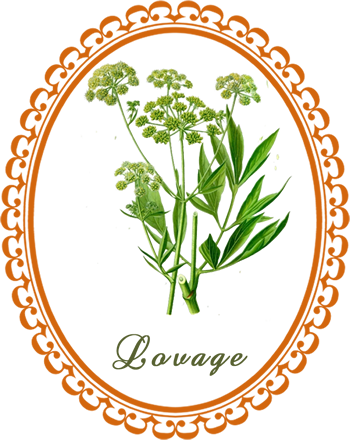
Lovage: A herb of ancient medical repute, used mainly for digestive complaints, edema, skin problems, menstrual irregularities and fever ...
Common Names: Lovage, Love Root, Sea Parsley
Botanical Name: Levisticum officinale
Family: Apiaceae
Plant Type: Hardy perennial
Parts Used: Leaves, roots, stems, and seeds
Flowering: June or July
Lovage is indigenous to the Mediterranean region, growing wild in the mountainous districts of the South of France, in northern Greece and in the Balkans.
Description: Lovage is a stout perennial plant with a thick, fleshy, carrot-shaped root that is five to six inches long, greyish-brown on the outside and whitish inside. Thick, erect hollow and channeled stems grow three to four feet tall. It has dark green leaves that are divided into narrow wedge-like segments similar to celery. The stems divide towards the top to form opposite whorled branches, and in June or July the plants blossom with umbel yellow flowers, similar to those of fennel, followed by small, yellowish-brown, strongly aromatic fruits.
Cultivation: Lovage is a perennial hardy to zone 3. It prefers moist, fertile, well-drained soil in full sun to partial shade. Sow seeds in spring or autumn in a greenhouse, then plant out in a permanent position in summer. Or propagate by dividing mature plants in spring or autumn.
Harvesting: Harvest leaves before the plant flowers, and dry. Pick seeds when ripe in late summer, then dry. Dig up roots of three-year old plants in early spring or autumn. Use fresh or dry.
Culinary Uses: Lovage tastes like celery. Use the leaves fresh in salads or in soups, stews, and sauces. Use the stems as you would celery stalks, and the seeds are used in pickling, salad dressings, and sauces.
Lovage Magick
Love. Friendship.
Gender: Masculine
Planet: Sun
Element: Fire
Carry the seeds to attract love and new friendships.
Place a lovage leaf in each of your shoes to ensure safe travel and to remove fatigue.
Take a lovage bath before you go out to make yourself more attractive and open your heart to love.
Herbal Healing with Lovage
Cosmetic Uses: An infusion of lovage seeds is said to erase freckles.
Medicinal Actions: Antibacterial, antifungal, antiseptic, antispasmodic, aphrodisiac, carminative, deodorizer, depurative, detoxifier, diaphoretic, digestive, diuretic, emmenagogue, expectorant, febrifuge, laxative, parasiticide, revitalizing, stimulant (digestive system and kidneys), stomachic, warming
Medicinal Uses: An infusion of the seeds leaves or roots reduces water retention and assists in the elimination of toxins, making it useful in the treatment of tissue congestion, gout, edema, poor circulation and rheumatism. Lovage root is used to stimulate urine flow and in menstruation imbalances such as amenorrhoea (absence of menses) and dysmenorrhoea (painful menstruation). In Asian countries, the stems are eaten to strengthen the body's defenses against infection and for cholera disease. It is a warming tonic for the digestive and respiratory systems, easing indigestion, wind and bronchitis.
Contraindications:
Avoid lovage if you are pregnant or have kidney problems.
Body Care with Lovage
- To aid slimming with a mild detoxification, take 1 cup lovage leaf infusion three times daily, as needed.
- To reduce a chronic cough, take a small glass of warm lovage cough potion after a meal, as necessary.
Infusion: 1 teaspoon dried or 2 teaspoons fresh lovage leaves in 1 cup just-boiled water.
Cough potion: Mix 3 teaspoons dried lovage root, 3 teaspoons dried sage leaves and 20 g (3/4 oz) fennel seeds in 2 cups red wine. Steep for 2 days, then strain. Bottle, then store for up to 6 months.
Source: The Essential Herbs Handbook by Lesley Bremness
If you appreciate the information provided,
please help keep this website running. Blessings!
© 2008-2025 aromaworx.ca. All rights reserved.

